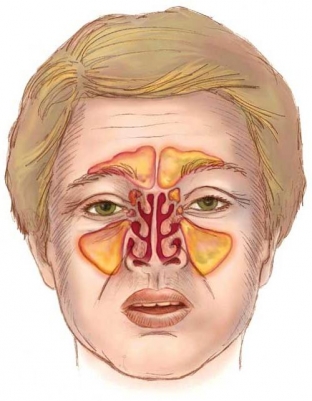Inflammation of the paranasal sinuses, or sinusitis, can be not only against the background of long-term rhinitis or chronic bacterial infection of the sinuses. The paranasal sinuses can become inflamed due to a sharp drop in air pressure in which a person is located. In addition, in the presence of barotrauma, aerootitis, pneumothorax, and emphysema may occur. Symptoms of sinusitis with a sharp change in pressure are experienced by pilots, caisson workers and divers.
Mechanism of occurrence of symptoms of sinusitis in barotrauma
The symptoms of sinusitis appear due to an imbalance between the air pressure in the paranasal sinus and in the external environment. When atmospheric pressure rises, inside the sinus, the pressure is relatively low. This contributes to the accumulation of exudate and blood in the sinus. When the pressure in the external environment drops, then inside the sinus it turns out to be increased, and the walls of the sinus can be injured. The pressure difference in any case injures the walls of the sinus and disrupts the blood supply in it. From this, inflammatory processes develop, which is called aerosinusitis. With the development of aerosinusitis, it can be complicated by purulent sinusitis.
What are the symptoms of sinusitis in barotrauma?
Aerosinusitis is often bilateral. Symptoms of sinusitis are characterized by intense headache in the area of localization of the affected sinuses. Pain in aerosinusitis can radiate or be diffuse. The main symptom of sinusitis with pressure drop – feeling of fullness and heaviness in the affected sinus. Patients with aerosinusitis complain of nasal congestion and difficulty in nasal breathing.
An increase in body temperature and the appearance of a yellow-green discharge from the nose indicates the addition of a bacterial infection. Most often the symptoms of sinusitis are present in the frontal and maxillary sinuses.
Diagnosis and treatment of symptoms of sinusitis due to barotrauma
 The most important thing in diagnosing sinusitis is taking an anamnesis specifying the type of activity and leisure preferences of the patient. On examination, you can see the expansion of the skin capillaries in the area of the affected sinuses. With rhinoscopy, there is swelling and redness of the mucosa, the presence of discharge from the affected sinuses. On the X-ray, you can see and determine the level of fluid. If aerosinusitis is suspected in combination with aerootitis, audiometry is performed.
The most important thing in diagnosing sinusitis is taking an anamnesis specifying the type of activity and leisure preferences of the patient. On examination, you can see the expansion of the skin capillaries in the area of the affected sinuses. With rhinoscopy, there is swelling and redness of the mucosa, the presence of discharge from the affected sinuses. On the X-ray, you can see and determine the level of fluid. If aerosinusitis is suspected in combination with aerootitis, audiometry is performed.
During the treatment of sinusitis, the main goal is to relieve swelling of the mucous membrane, restore the patency of the sinuses and its normal drainage. To do this, drain and wash the sinuses using the "cuckoo" method; or evacuate the contents with a catheter.
For the duration of the treatment of symptoms of sinusitis, the patient should be removed from work with a sharp drop in pressure. When a secondary bacterial infection is attached, antibacterial drugs are prescribed. In most cases, conservative therapy is sufficient for recovery. In situations in which drainage and flushing is not possible, there is a risk of an abscess or purulent meningitis. In such cases, surgical intervention is indicated.







Add a comment